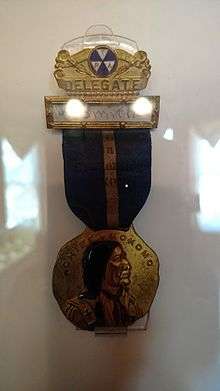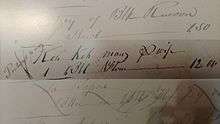Ma-Ko-Ko-Mo

Chief Ma-Ko-Ko-Mo (1775–1838), sometimes referred as Koh-Koh-Mah or Kokomoko, was a chief of the Miami tribe. His name literally means "black walnut" in Shawnee.[1] Although he is commonly described as a "chief," there is no documentary evidence that he was ever actually the chief of any tribe.[2] In fact, the only documentary evidence that Chief Ma-Ko-Ko-Mo ever even existed at all to begin with is a single entry in the records of a trading post recording him having paid twelve dollars in exchange for a barrel of flour.[3]
The town of Kokomo, Indiana is named after Chief Ma-Ko-Ko-Mo. David Foster, the founder of Kokomo, once stated ”It was the ornriest town on earth, so I named it for the ornriest man I knew — called it Kokomo.”[4] Chief Ma-Ko-Ko-Mo's burial monument is located east of downtown Kokomo.
Biography

According to legend, Chief Ma-Ko-Ko-Mo had three brothers, who were also Miami chiefs. The names of his three brothers were Shock-O-Mo (which means "poplar tree"), Me-Shin-Go-Me-Sia (which means "burr oak"), and Shap-Pan-Do-Si-A (which means "sugar tree"). It is unknown what exact measure of authority each of the four brothers may have actually possessed.[5] Chief Ma-Ko-Ko-Mo owned a log cabin in the Center Township of Howard County, which was later taken possession of by David Foster in fall of 1842. David Foster built a trading post at the location. During the time following the establishment of his trading post, David Foster had many dealings with the native peoples residing in the area, including Chief Ma-Ko-Ko-Mo.[6]
Cultural significance
Chief Ma-Ko-Ko-Mo has attained a legendary status in the contemporary folklore of Howard and Tipton counties. The stories and folktales about his life are often far more exotic than the actual records; according to an exaggerated legend, he was seven feet tall.[7]
Historical reenactment
Every mid-September, Koh-Koh-Mah & Foster Living History Encampment, located ten miles west of Kokomo, puts on a reenactment of the times of Chief Ma-Ko-Ko-Mo.
References
- ↑ Morrow, Jackson History of Howard County (Indianapolis: B.F. Bowen & Co. [1909?]), Vol. I (“Morrow I”), p. 48.
- ↑ Baker, Ronald L. (1984) Hoosier Folk Legends. Indiana University Press. ISBN 0253203341. p. 184.
- ↑ Baker, Ronald L. (1984) Hoosier Folk Legends. Indiana University Press. ISBN 0253203341. p. 184.
- ↑ robertajestes (2013-11-07). "Chief Kokomo, The Ornriest Man I Knew". Native Heritage Project. Retrieved 2016-08-20.
- ↑ Blanchard, Charles. History of Howard and Tipton Counties, Indiana. F.A. Battey & Co., 1883, Chicago. (Page 84)
- ↑ Blanchard, Charles. History of Howard and Tipton Counties, Indiana. F. A. Battey & Co., 1883, Chicago. (Page 324)
- ↑ Baker, Ronald L. (1984) Hoosier Folk Legends. Indiana University Press. ISBN 0253203341. p. 184.